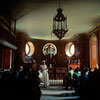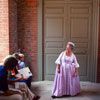BACKSTORY (1699 —Present): As a child, I was a huge history buff, and our 1971 summer family trip to Virginia was a dream come true. Imagine Disneyland for history buffs. Colonial Williamsburg is a re-creation/restoration mix of what this important historical city was like back in the 18th Century.
BACKSTORY (1944): "Eighteenth Century Life in Williamsburg, Virginia" (1944), was the first educational film ever made in the U.S. It depicts a day in the life of a Williamsburg family and other townspeople, in scenes that give flavor to a typical day in 18th-century Williamsburg. From the New York Sun, October 1, 1943, by Norris Harkness
Let's Make Pictures
Making Visit to Colonies by Kodachrome.
Yesterday afternoon we spent forty-four splendid minutes in the eighteenth century, but so fascinating was the show that took us there that it seemed like not more than ten or fifteen. And we were sorry to come to "The End" when it was over.
The occasion was the preview of "Eighteenth Century Life in Williamsburg, Virginia," a 16mm Kodachrome sound film that carried us back to the period of George Washington's young manhood and let us see and live with Christopher Kendall for a full day. The film comes from Colonial Williamsburg, Inc,. the orgniaxation that has reconstructed old Williasmburg and brought it back to life for all of us to know.
Ut is a simply made film with no drama, no excitment and no humorous events except possiblythe audience's reaction to the plentiful display of meant and butter. It is the simplest kind of record of what Williamsburg must have been in the days of the Virginia Colony, but it held a critical audience throughout every short minute of its showing.
The day began with the preparations for Christopher Kendall's breakfast and his ablutions. We envied him his waffles and bacon and eggs—we wouldn't mention the courtesy of the younger members of his family—and the comfortable, unhurried hours that filled the days. We went with him to his cabinet shop and watched him and his men use their hand tools, so much like those in use today, and the few simple, almost crude machines that workmen then possessed. We saw him present for final approval a desk made for the governor and then we followed him home again and through his pleasant, homely evening.
We saw his family, his home and a gliimpse of his life, but the makers of the film did not insist on our doing a travelogue of Williamsburg. They spared us that, and instead allowed us to see just enough to make Williamsburg and life there in Colonial days come alive. The commentary by Conrad Nagel added to our enjoyment, but—and this is the sole adverse comment, if it really is one—the accompanying century music bothered us a bit until the film made us forget it.
The film was made to show how moving pictures can make ordinarily dry museum material come alive. It lifts the still inaction of a display of architecture and clothes into a moving, real knowledge of what used to happen when America had a king and the Revolution was half a generation in the future. Our only quarrel with "Eighteenth Century Life in Williamsburg, Virginia," is that it is too short.
Captions for accompanying publicity shots below:
1. The Royal Governor was the King's representative in the Virginia Colony and had great power in controlling the laws made by the colonists.
2. The colonial kitchen was without benefit of refrigeration, gas, electricity, or canned goods.
3. Father and son leaving home for work together. No other scene could be more representative of village life in colonial America than this quiet street in Williamsburg.
4. The coach of the Royal Governor was a familiar sight in Williamsburg.
5. The roast is fixed on a spit so it may be turned from time to time for even cooking.
6. In the shop of Christopher Kendall, journeymen and apprentices are engaged in the production of fine furniture.
7. Large families, wholesome natural food, and plenty of it made the dining room an important feature of the colonial home.
8. The blacksmith was a mighty man indeed during the eighteenth century, for, in addition to shoeing horses, he produced many of the implements and tools used in other crafts.
9. Long months, even years, will be required for the apprentice to develop the true eye and sure hand that distinguishes the skilled craftsman.
BACKSTORY: I was contacted by Bruce MacNeil who once worked in Colonial Williamsburg. He was kind enough to share some of his memories of his experience as well as identifying some of the other employees who worked there with him.
By way of background, my parents moved to Newport News VA in 1962 when I was 6. My Williamsburg adventures actually started in 1960 when my Dad was in grad school at William and Mary. Throughout the 1960s and into the early 1970s, we were regular visitors, probably 1 or 2 times a month, on average. I did all the children activities, starting with the TriCorn hat tour, and we regularly went to all of the evening film presentations, including 18th Century Life in Williamsburg. So, in 1975, my Mom, after years of talking about wanting to work for CW (Colonial Williamsburg), was selected as an Exhibition Buildings historical interpreter, and would work there through 1991. I joined her in the Bicentenial year of 1976 as a summer college hire and part timer in the off season. My CW time in costume would span 3 plus years before I was forced to enter the real workforce several months after college graduation. I confess that my CW nostalgia has grown recently, as it brings back memories of a happier time in my life. Secondly, I just learned of the death about a year ago of a CW co-worker from the 1970s which brought back many more memories of our times together. I still have one friend of my mother's who worked at CW for almost 40 years that I stay in regular contact with - she keeps me filled in.
When I say, things in CW have changed a lot, much of it has to do with how things are presented with the employees role playing, which is what they believe is appropriate in today's environment. In the 50s through the 90s, you had a trained staff of historical interpreters who worked in the various exhibition buildings. You rotated among all the buildings, rarely working in the same one two days in a row. These were the public buildings, houses and taverns, not the craft shops. They were their own department. A seasonal person like myself only worked in some of the buildings - you had to be a regular employee, or at least a long-term seasonal employee, to work in all the exhibition buildings. What I liked about the interpretive staff was that we were diverse, had a very wide age range, all sorts of backgrounds (many retired professional people worked there as a second, part-time, career), seasonal employees who were college students and school teachers, and a full-time staff. But just about everone took their work seriously, and wanted to be as helpful as we could to all of our guests.

 I believe the woman in the photo at left is Cynthia Long, who worked for CW for close to 40 years, from 1968 on, but in a cost cutting move, her position was eliminated. A shame really, as she dedicated her life to CW. She still is allowed to live in a restored house on Duke of Gloucester Street, but it's still a shame that's how her career ended. I am certain the woman at right is Dorothy Gardo, known to all of us as Dot Gardo. She was quite a character.
I believe the woman in the photo at left is Cynthia Long, who worked for CW for close to 40 years, from 1968 on, but in a cost cutting move, her position was eliminated. A shame really, as she dedicated her life to CW. She still is allowed to live in a restored house on Duke of Gloucester Street, but it's still a shame that's how her career ended. I am certain the woman at right is Dorothy Gardo, known to all of us as Dot Gardo. She was quite a character.